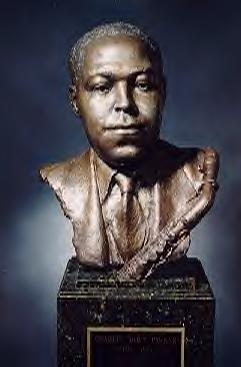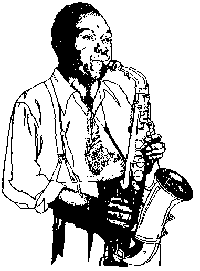 |
 |
 |
| Saxophonist Charlie "Yardbird" Christopher Parker Jr. was born in Kansas City, Kansas on August 29, 1920. The only child of Charles and Addie Parker, Charlie Parker would go on to reinvent the world of jazz, and at the same time becoming one of the world's most important saxophone players of all time. A master of improvisation, Parker would create a new genera in jazz that would then change the way in which people viewed jazz for years to come. In 1927, the Parker family moved to Kansas City, Missouri. This was mainly to help his father, Charles Sr., continue his career as an entertainer in the Vaudeville ciruits. But this move to a city where the jazz, blues, and gospel musical forms where flourishing would prove to be an important and influential event in the life of Bird. It was at this time in his life that Parker began to study music. "When he was a child, he wanted to be a music maker," said his mother. Bird began playing the baritone horn as a freshman at Lincoln High School. When he was fifteen years old he developed a passion for, and began playing the alto saxophone. At the young age of sixteen, Parker dropped out of school and joined Local Union 627, a musicians union, and his career as a musician was officially under way. It was also around this time that Charles Sr. was forced out of his Vaudville career and into a job as a railroad pullman. Frequently away from home for long periods of time, Charles Sr. saw less and less of his wife and son. Finally in the early to mid 1930s he left his family, and eventually drifted out of their lives all together. From 1935 to 1939 Bird worked in Kansas City with several local jazz and blues bands. With his father gone and his mother mostly working nights, Parker would spend most of his nights at local bars and clubs trying to perfect his saxophone abilities. Charlie Parker mainly honed his skills through trial and error, and by listening to old jazz musicians. During his night club days, he studied such saxophonists as Herschel Evans, Ben Webster, and Lester Young. At the age of eighteen, Yardbird moved to Chicago and then finally to New York City. He first worked in restaurants as a dishwasher, until he was able to land gigs as a musician. In New York, he played with such greats as Earl "Fatha" Hines, Cootie Williams, Billy Eckstine, and Dizzy Gillespie. Parker proved to be a very versitile musician. He played the alto sax, tenor sax, doubled on clarinet, and experimented on practically every brass and woodwind instrument. Charlie Parker's most significant contribution to the musical history books probably rests in him being credited as the originator of Bebop. Bebop, or Bop was a new complex style of jazz that followed the Big Band and Swing eras. Usually for small groups, bebop was meant for attentive listening rather then dancing. This new style of jazz was a revolution in harmony and rhythm, and emerged as a new and diverse musical language. The typical Bebop ensemble consisted of a saxophone, trumpet, piano, bass, and percussion. Bebop is not concidered by experts to be a break from the past as much as a logical evolution of it. In this new form, Parker used chord-based changes of popular standards while introducing more extended harmonic content along with faster and more complex rhythms. This new style of jazz showed itself to be more challenging to the young and upcoming musicians, but more bewildering to audiences which had been raised on Big Band. This was especially true with the casual jazz fans. Audiences began to back away from jazz at this time in search of more simplified forms of music, and Bebop came to evolve jazz into a more closed musical culture during this time. New York audiences where more receptive to this new sound then their West Coast counterparts, and while touring with Dizzy Gillespie's Trio in Los Angeles, Bird found himself becoming more and more dependent on drugs and alcohol. Performing for these hostile crowds pushed Parker to having a nervous breakdown, and he was confined to Camarillo State Hospital after his first suicide attempt. It was because of this wild way of living, which Bird so readily exhibited, that Bebop became defined as "outlaw" music along with a lifestyle that many chose to follow. Charlie Parker did bounce back from his hospitalization two years later and was now leading his own group on the West Coast. In 1949, Birdland opened in New York. This dance hall was erected to honor Parker's namesake and to imortalize his playing style. in 1954, another suicide attempt put Parker in Bellevue Hospital. On March 5, 1955, Parker played his last public performance at Birdland. Charles Christopher Parker Jr. died only one week later on March 12, 1955, in a friend's New York apartment.He died at the age of thirty-five due to heart failure, pneumonia, and cirrhosis of the liver. his funeral was held in Harlem, New York, and he was later buried in Lincoln Cemetary in Kansas City, Kansas. A sculpture was also later erected in his honor in Kansas City in its historical 18th and Vine District. Over the course of his life Charlie "Yardbird" Parker married four times and had five children, but it was his musical legacy that he will forever be remembered for. Charlie Parker came to be known as the most influential saxophone and jazz musician of the 1940s, and one of the most famous African-American musicians of all time. His contributions to the music and culture of his period are truely immeasurable. He was an amazing musician who gained wide exception and recognition for his brilliant solos and groundbreaking improvisations. Over his short life, Parker's musical genius brought new innovation to the world of jazz. He rewrote what jazz was, and branched it off into something new and inspirational. Charlie Parker was an influential and poweful force in music history. His spirit lives on today in his music and he continues to inspire and influence musicians worldwide. |
| By: Eric L. Cilli Anderson College MUS 110 Dr. Lyman Golden 2000 |